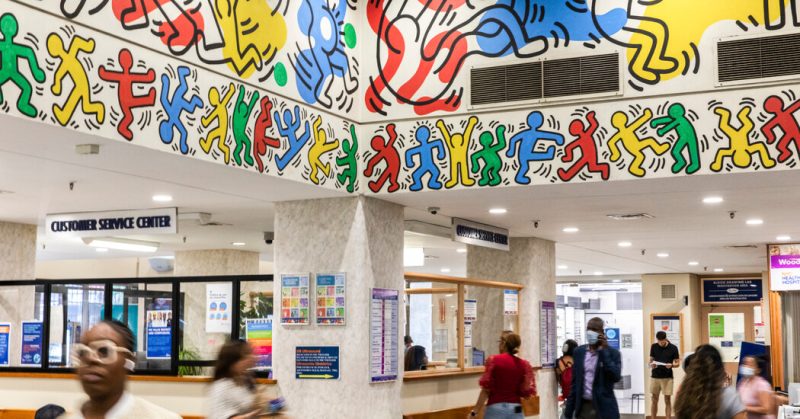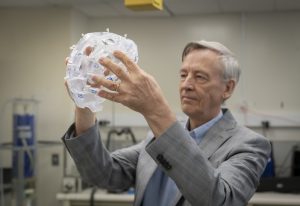A Dazzling Art Collection, Hiding in Plain Sight

The sign on the wall suggests: “Look above you.”
But really, no prompt is needed. It is impossible not to notice the parade of red, blue, green and yellow figures dancing across the walls, winding around air vents and windows, right up to the ceiling.
It is, unmistakably, the work of Keith Haring.
Only this art is not in a museum or gallery; it’s the otherwise unremarkable lobby of Woodhull Hospital in Brooklyn. In 1986, when Mr. Haring was already well known, he perched for long hours atop scaffolding at the public hospital, laboring over a three-part mural that starts in the atrium and continues down two long corridors.
The Haring mural is just one of the surprises among the 7,452 works of art that have been amassed over nearly a century by New York City’s sprawling public hospital system, which serves more than one million patients every year.
It is one of the largest public art collections in the country — hiding in plain sight.
A ceramic-tile mosaic was created by Helen Frankenthaler for the lobby of North Central Bronx Hospital. A vibrant collage of life on a city block by Romare Bearden welcomes visitors to the chapels of Bellevue Hospital in Manhattan (a similar Bearden mural is at the Metropolitan Museum of Art), while one floor above, there is an Andy Warhol silk-screen of flowers.
The collection contains work by serious artists, said Barbara Haskell, a curator at the Whitney Museum of American Art. “There’s a number of things that we would enjoy having at the Whitney for sure.”
Just how did the city’s public hospitals, which serve as a safety net for the poor and uninsured, come to be in possession of such a collection?
It is still something of a mystery. There seem to be incomplete records of how pieces were acquired, and, if the records exist, they have been buried in the municipal archives.
But the result is an accidental and largely forgotten collection that even those in the art world are surprised to find out about.
Stephanie Cassidy, the head of research and archives for the Art Students League of New York, where generations of influential artists have studied, knew there were murals by Charles Alston, who had taught at the League, at Harlem Hospital, but she did not have “a sense of that being the tip of the iceberg.”
Though the collection has not been appraised, it is probably worth many millions of dollars, according to art experts. The Haring mural alone could fetch millions. In 2019, another Haring mural — carved out of a stairwell at Grace House, a former convent and home of a Catholic youth organization in Manhattan — sold for more than $3.8 million at auction.
A review by Heritage Auctions of just 11 other important works in the collection has put their total value between $8 million to $10 million, said Roberta Kramer, a senior vice president of strategy and business development at the auction house.
“Only in New York,” Ms. Cassidy said, “could you see a collection like this in public hospitals.”
***
The first real piece of fine art was commissioned for New York’s public hospitals in 1932 for the lobby of Kings County Hospital in Brooklyn.
There, Vincent Aderente created an ethereal scene of classical figures in flowing gowns symbolizing truth, science and knowledge. “Mural Depicts Hospital’s Noble Work in the Cause of Humanity,” a local newspaper observed at the time.
Dozens of murals followed. In the waiting room of a Queens hospital, panels illustrated the development of medicine. A mural in a children’s ward in Lower Manhattan transported characters from Alice in Wonderland to New York destinations like the Central Park Zoo and Coney Island. A series at Harlem Hospital — one of the first major government commissions awarded to Black artists — showed Black people at work and play through history.
The earliest pieces had a utilitarian purpose: They were primarily commissioned through government agencies and programs, like the Works Progress Administration, to put people — in this case, local artists — to work during the Depression.
The murals also helped reinforce “the idea that art should be public,” said Ms. Haskell of the Whitney.
The collection grew in later decades as donations from artists, private collectors and philanthropists poured in from New York’s booming art world. After World War II, schools including the Art Students League filled up with a new generation of artists.
In the 1970s and 1980s, as the public hospital system expanded, the collection benefited from government policies calling for a portion of construction costs to be spent on art.
A volunteer advisory board made up of museum leaders and art experts was put in charge of reviewing and selecting art for the hospitals. But not every commission went smoothly.
Mr. Bearden’s mural, “Cityscape,” was originally placed in Lincoln Hospital’s new building in 1976. But it was quickly taken down after local officials complained that the collage, which has Black figures, did not include the Puerto Rican community around the Bronx hospital.
“I, too, hope that all things relative to the mural can be straightened out,” Mr. Bearden wrote in a letter thanking a supporter. “As you can imagine it’s enough doing one without having to be a politician also.”
The mural resurfaced years later at Bellevue.
Mr. Haring offered to paint the Woodhull mural at his own expense, though it is not known exactly what drew him to the Brooklyn hospital.
“My sense is that he just wanted to be of service,” said Gil Vazquez, the executive director of the Keith Haring Foundation. “Art heals, and he knew that.”
In his application to the city, Mr. Haring wrote: “Since this is a hospital, I assume that means the work should be positive, uplifting, unaggressive, imaginative and comforting.”
In the margins, he sketched out what he later painted: “very simple human and animal figures, dancing, playing, break-dancing, etc.”
Mr. Haring, by that time a celebrity known for his large public murals, painted alone at Woodhull; he became a fixture, smiling at patients and hospital workers and climbing down from his scaffolding for conversation.
His mural has become the pride of Woodhull.
“It is part of the hospital,” said Dr. Lisa Scott-McKenzie, Woodhull’s chief operating officer, who in 1986 had just started as a secretary and didn’t know who the painter on the scaffolding was.
The mural is “deeply ingrained in who we are,” she said, “and the respect that we have for our community.”
***
Even as the hospital collection was expanding, it was showing its age. Several of the Depression-era murals had fallen into disrepair. Other works were put in storage and largely forgotten.
But the collection would soon get help from a powerful friend — then-Mayor Edward I. Koch, a vocal supporter of public art.
Less than a decade after Ms. Frankenthaler’s mural was installed in the lobby of the Bronx hospital in the 1970s, it had been damaged. Her concerns reached the mayor.
Mayor Koch and hospital leaders took steps to better manage and preserve the collection. In addition, money set aside for art from hospital construction projects was used to “accelerate the rescue and conservation” of the early murals, said Patricia E. Harris, who led the city’s art commission back then. “We were able to bring them back to life.”
In the decades since then, however, the hospital system has faced financial turmoil. In the mid-1990s, it was reorganized, and responsibility for the art was simply left to each hospital. In 2016, it tethered “on the edge of a financial cliff” as officials proposed restructuring and increased city subsidies.
When Dr. Mitchell H. Katz took over in 2018 as the president and chief executive officer of NYC Health + Hospitals, the agency was struggling with a budget gap that was expected to balloon to $1.8 billion.
To Dr. Katz’s surprise, it also had a valuable art collection.
“I did not want to close hospitals,” he said. “And I certainly would have had to consider selling parts of the art collection if we were not able to close the gap.”
But it did not come to that.
Dr. Katz said the art work was not targeted for sale because it would have offered only temporary, one-time relief from the fiscal crisis. Instead, hospital officials focused on making the system more efficient, including changing insurance billing practices to collect for medical services that had gone unpaid.
Selling art work that had been donated to hospitals for their patients “would have been very bad karma,” Dr. Katz added.
Beyond that, the collection is significant because it includes many prominent artists of color like Mr. Bearden and Mr. Alston. “It’s a very rich cultural history,” said Nigel Freeman, the director of African-American Art at the Swann Auction Galleries.
***
Now New York’s public hospitals are re-embracing their collection, part of a growing movement in health care to heal with art. Hospital officials created a department, Arts in Medicine, in 2018 to oversee the collection and are busy planning exhibits and a new display area at Bellevue.
The artwork helps create an “enriched environment” that can lower stress, anxiety and blood pressure, improve moods and lead to faster healing, said Susan Magsamen, the director of the International Arts+Mind Lab at Johns Hopkins University School of Medicine.
“Hospitals are one of the most stressful experiences anybody ever has — right up there with going to school the first day,” she said.
Cedars-Sinai Medical Center, a private nonprofit in Los Angeles, has displayed works by Picasso, Joan Miró, Marc Chagall, Willem de Kooning and others, using some for Fitbit walking tours and scavenger hunts for patients.
And a giant pumpkin sculpture by Yayoi Kusama sits on the main campus of Cleveland Clinic, a private nonprofit that has collected more than 7,000 works of contemporary art.
In New York, the art is now maintained through donations and grants, and when it is part of a building like the murals, by the agency’s capital funds, said Larissa W. Trinder, the assistant vice president for Arts in Medicine. No operating funds are used.
Additionally, $4.5 million in grants from the Laurie M. Tisch Illumination Fund has helped develop arts programming, according to Rick Luftglass, the foundation’s executive director.
Recently, at Lincoln Hospital, staff members gathered around a William King sculpture for a workshop with an educator and an art therapist from the Whitney. Then, they crafted their own art and shared about their stresses and anxieties.
Ms. Trinder is trying to raise at least $20 million for an endowment to care for the collection. Meanwhile, a John Rhoden sculpture at Harlem Hospital awaits restoration. Other works, including several Ansel Adams prints, are in storage waiting to be framed.
To expand public access, the collection is being digitized to display on a free app for arts and culture, Bloomberg Connects. Physical signs with QR codes are being placed next to the art.
At Woodhull Hospital the other day, Tijae Medina, 13, was getting anxious about his dental appointment. But then he turned down a gleaming white corridor and looked up to find a spotted dragon in high heels. Or was that a cow?
He instantly felt more at ease.
“I feel like walking into a hospital is scary,” he said. “It took my mind off it for a second.”







